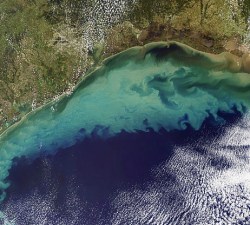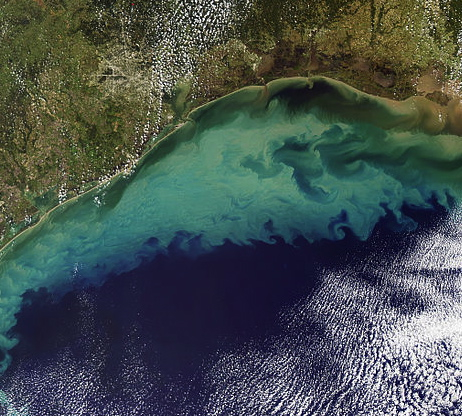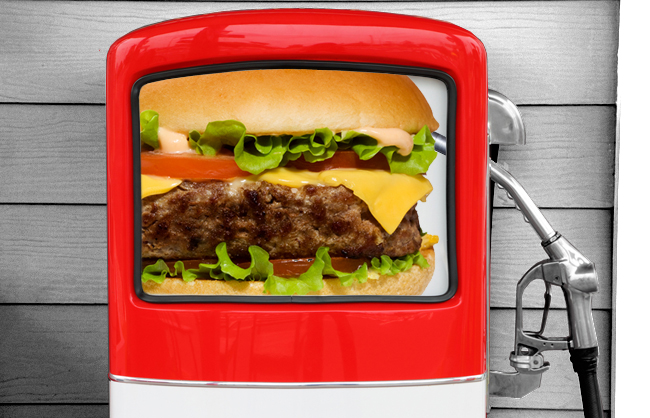
Photo courtesy of NASA.
Last week, I wrote about how this year’s unusually small Gulf dead zone may offer less reason to celebrate than you’d think. Yes, less rainfall has indeed meant less farm runoff into the Mississippi, resulting in fewer nutrients from fertilizer and livestock in the Gulf, and thus a smaller lifeless aquatic area (or “dead zone”). In normal years, however, this zone is still continuing to expand. And, until the face of farming changes — so that commodity producers rely less heavily on synthetic nitrogen fertilizer and animal agriculture is less concentrated — this pattern isn’t going to change.
As it turns out, there’s more to the relationship between drought and nitrogen than I’d originally thought. Eric Davidson, executive director and senior scientist at Woods Hole Research Center — a Massachusetts-based think tank focused on climate and natural resources — shared some additional science that suggests we might really want to hold off on celebrating.
You see, nitrogen is a cycle. In nature nitrogen is produced by animal waste or decomposing organic matter and absorbed by plant life. Ideally agriculture would be a closed loop, meaning it would create just about as much nitrogen as it needed. But, in the case of industrial agriculture, the cycle is out of balance. In order to grow huge quantities of food very quickly, most big commodity farmers — read: corn, wheat, and soy — use synthetic nitrogen fertilizers made from fossil fuels. (For more on the complexities of nitrogen fertilizer, read Stephanie Ogburn’s “The dark side of nitrogen.”) In a normal year, some of the nitrogen from the fertilizer is absorbed, and the rest either washes into the Midwest’s waterways (which lead eventually to the Gulf) or ends up in the air as nitrous oxide.
This year, according to Davidson, all that corn we’re seeing all over the media has been badly stunted — if not straight-up parched to death. So it isn’t absorbing its standard dose of nitrogen — and an already-whacked scenario will probably be thrown even further out of balance.
As Davidson puts it: “In the spring, farmers made a calculation of how much nitrogen they thought their crop would need … Now the big question is: Where will the nitrogen go? If it rains, it’ll get washed away. If the soil gets very wet while it’s still warm, then there are certain types of bacteria called denitrifying bacteria that will convert it to a potent greenhouse gas, which goes up into the atmosphere.”
Is there a chance all this nitrogen will stick around in the soil and help farmers use less fertilizer next year? That depends, says Davidson. If too much rain falls before winter, it’s unlikely.
“It’s a very nonlinear process,” adds Davidson, and therefore ultimately impossible to predict. But with this added piece of the puzzle it’s looking entirely possible that we could still see the effects of this year’s nitrogen excess in the form of next year’s dead zone. In other words, there really is no free lunch.



